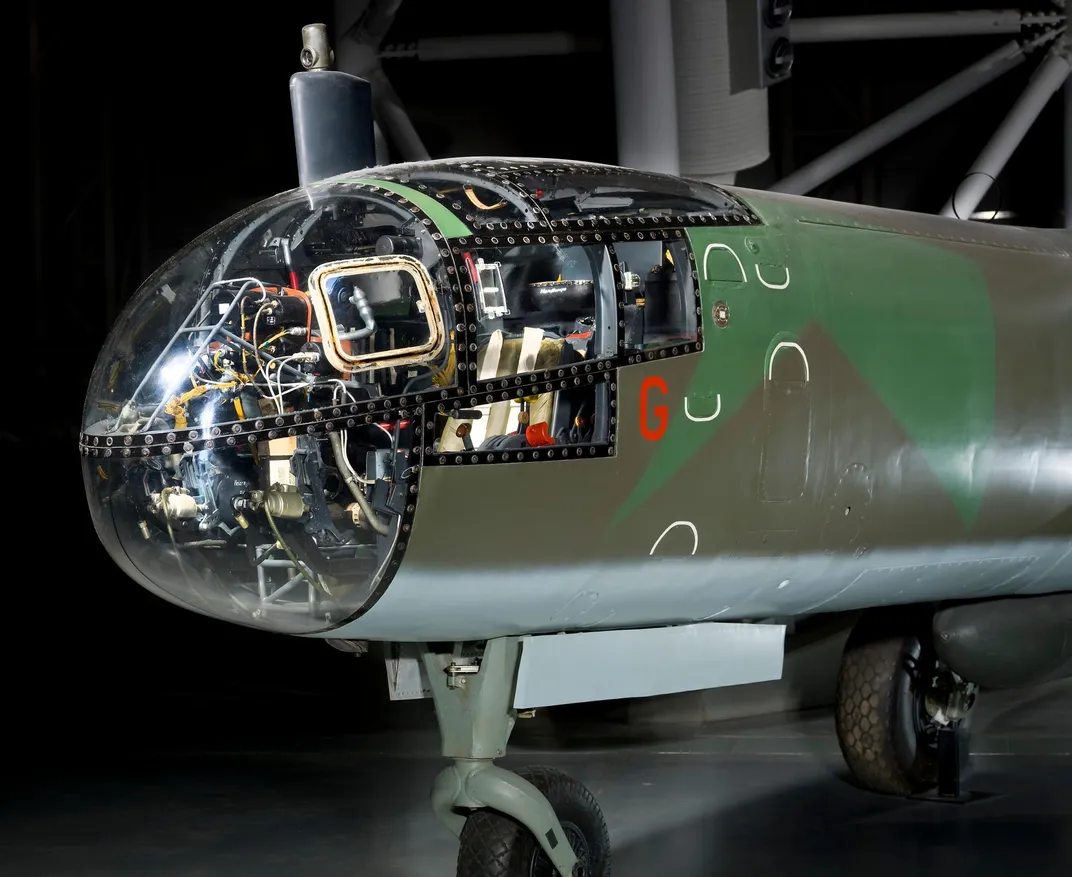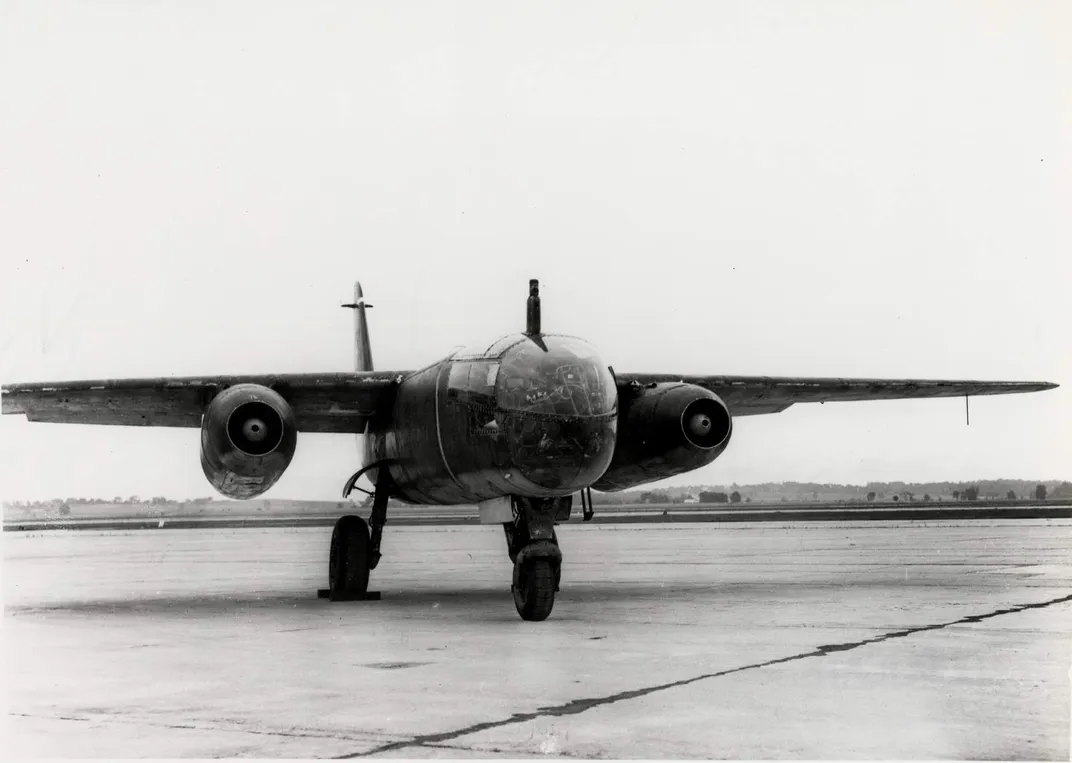With Lightning Speed and Agility, Germany’s Ar 234 Blitz Jet Bomber Was a Success That Ultimately Failed
Only one is known to survive today and it is in the collections of the Smithsonian’s National Air and Space Museum
/https://tf-cmsv2-smithsonianmag-media.s3.amazonaws.com/filer/37/ad/37adddd3-b9b1-4bb9-b88d-4dc30b6e8114/deliveryservice_idnasm-2005-420.jpg)
On Christmas Eve, 1944, American forces were dug in around Liege in Belgium and prepared for just about anything. Eight days earlier, four German armies had launched a surprise attack from the Ardennes Forest, using one of the coldest and snowiest winters in European history as cover from Allied air superiority.
The Nazis smashed through stretched-thin defensive positions and were pushing towards the port of Antwerp to cut off Allied supply lines in what would become known as the Battle of the Bulge.
With savage fighting on many fronts, American troops at Liege were on high alert in case the Germans tried something there—though they didn’t expect what happened next. With the weather clearing, aircraft from both sides were flying once again. High above the Belgian city came the sound of approaching planes. The engine rumble from these aircraft was not typical, though.
Rather than the reverberating growl of piston-driven engines, these aircraft emitted a smooth piercing roar. They were jets, but not Messerschmitt Me 262s, history’s first jet fighter. These were Arado Ar 234 B-2s, the first operational jet bomber to see combat. Nine of them were approaching a factory complex at Liege, each laden with a 1,100-pound bomb.
Luftwaffe Captain Diether Lukesch of Kampfgeschwader (Bomber Wing) 76 led the small squadron on the historic bombing run. Powered by two Jumo 004 B4-1 turbojet engines, the sleek planes zoomed in to drop their payloads and then quickly soared away. They were so fast that Allied fighters could not catch them.
Often overshadowed by more famous jets in World War II, the Ar 234 B-2—known as the Blitz, or Lightning—had caught the Allies by surprise when the nine soared through the skies on December 24, 1944.
History’s first operational jet bomber was designed and built by the Arado company. The plane originally began service as a scout aircraft. One had flown reconnaissance over Normandy snapping photos of supply depots and troop movements just four months earlier. But reconfigured as a bomber and operated by one pilot, who also served as bombardier, the Blitz was fast and agile. It easily eluded most Allied aircraft with its top speed of 456 miles per hour. The Germans also created two other versions of the aircraft—a night fighter and a four-engine heavy bomber—neither made it into full production.
The Allies were keen to capture the Ar 234 so it could be studied. It was not until the end of the war when they finally got their hands on a handful of them.
Only one is known to survive today and it is on display at the Smithsonian National Air and Space Museum’s Udvar-Hazy Center in Chantilly, Virginia. (The museum is currently closed due to the Covid-19 crisis.)
“The Allies were collecting all this German technology after the war,” says curator Alex Spencer. “The Army Air Force spent a good five to six years really studying what these aircraft were capable of doing—both their strengths and weaknesses. Some of the aerodynamic aspects of the Ar 234 and other jets were undoubtedly taken advantage of for some of our early designs, like the F-86 Sabre and other planes.”

The one-person bomber was innovative with its canister fuselage and tricycle landing gear while an autopilot system guided the aircraft on bombing runs and periscope bombing sights allowed for precision attacks. The Ar 234 was at least 100 miles per hour faster than American fighter planes, which could never catch the jet bomber in pursuit. But Allied pilots eventually realized the Blitz was especially vulnerable to attack at slower speeds during takeoff and landing.
Captain Don Bryan of the American Air Force was unsuccessful in his first three attempts to shoot down the Blitz, but he remained determined to score a kill. He finally did in March 1945 when he spotted one making a bombing run on the Ludendorff Bridge at Remagen in an attempt to prevent American forces from crossing the Rhine into Germany.
When he saw the jet bomber slow in a tight turn after dropping its payload, Bryan jumped at his chance. Blasting away with the .50-caliber machineguns in his P-51 Mustang, he knocked out one of the jet engines and was then able to get behind the bomber and shoot it down. Bryan’s was the first air-to-air kill of a Blitz.
While the Ar 234 is historic, its effectiveness as a jet bomber is questionable. According to Spencer, it arrived too late in the war and in too few numbers to have any significant impact and was rushed off the drawing board too soon with too many flaws. At best, it was an experimental aircraft that needed more conceptual consideration before it was pressed into service. All told, only a few hundred Ar 234 B-2s were produced with several dozen making it into combat.
“As with most of the so-called German ‘Wonder Weapons,’ they make me wonder,” Spencer says. “Everyone is enamored with them, but they really don’t live up to expectations. Same with the Blitz. It had its good points and bad points. As an attack bomber, it was not that effective.”

During a 10-day period in March 1945, the Luftwaffe flew 400 sorties against the bridge at Remagen in an effort to slow the Allied advance. Ar 234 B-2s from KG 76, as well as other German aircraft, made repeated attacks on the river crossing. All bombs missed their target.
“They made several runs at Remagen and they couldn’t hit the thing,” Spencer says. “It was such a squirrelly aircraft to fly and pilots weren’t used to it. They were learning to fly at speeds they were not used to and their timing was off. It’s new and interesting technology but as far as being a game-changer, I don’t buy the argument.”
The Smithsonian’s Ar 234 was captured by the British in Norway with the surrender of Nazi Germany on May 7, 1945. It had been flown there in the waning days of the war for safekeeping. The English turned over this plane, Werk Nummer 140312, to the Americans, who eventually flew it to a U.S. research facility. In 1949, the U.S. Air Force donated it along with other German aircraft to the Smithsonian. This Blitz had gone through extensive changes so American test pilots could fly it, and the museum undertook a major restoration effort in 1984 to get the Ar 234 back to its wartime condition.
“It was a basket case,” Spencer says. “It took two guys working on it almost five years to restore it. The jet engines and some of the navigational systems had been swapped out during testing, but our staff was able to replace most of that. Some 13,200 man/hours went into returning it to original condition. We’re still missing a few parts, but it’s about as close to 1945 as it can be.”
The restored Ar 234 went on view when work was completed in 1989. News media around the globe reported on the historic aircraft going on display, including a German-language aviation magazine.

In 1990, Willi Kriessmann happened to be leafing through that publication when he spotted the article. The German native, then living in California, read the report with interest and stopped short when he saw the Ar 234’s serial number: 140312. It looked very familiar, so he went and checked his papers from when he flew as a World War II Luftwaffe pilot.
“Out of sheer curiosity, I looked up my logbook, which I saved throughout all the turbulence of the war,” he wrote in his unpublished memoir, which eventually he donated to the Smithsonian. “Eureka! The same serial number!”
Just before Germany’s surrender, Kriessmann had transported the jet to several locations around Germany before flying it to Norway, where both he and the plane were captured by the British. He contacted the Smithsonian and sent along copies of his flight book for authentication. He was invited to the museum to see the Ar 234 again, where he was welcomed by Don Lopez, then deputy director of the National Air and Space Museum
“I finally faced ‘my bird’ on May 11, 1990,” he wrote. “It was a very emotional reunion.”
The Blitz was moved to the museum’s Udvar-Hazy Center , when the huge expansion site opened in 2003. Kriessmann visited once again at that time. In his memoir, he states how he was saddened that many of his fellow pilots would not be able to join him at the Smithsonian because they had not survived the war. But he was grateful his plane had.
“The (future of the) Ar 234 is now assured, I hope, at least for a while. Maybe eternity,” wrote Kriessmann, who died in 2012.
/https://tf-cmsv2-smithsonianmag-media.s3.amazonaws.com/accounts/headshot/dave.png)


/https://tf-cmsv2-smithsonianmag-media.s3.amazonaws.com/accounts/headshot/dave.png)